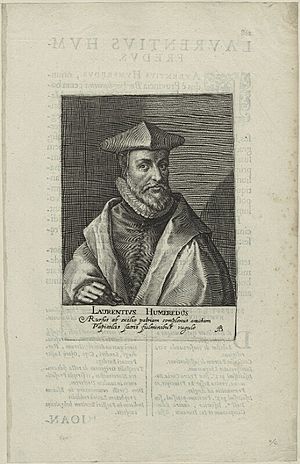Lawrence Humphrey facts for kids
Quick facts for kids
Lawrence Humphrey
|
|
|---|---|
 |
|
| Died | 1 February 1589 |
| Occupation | Theologian |
Lawrence Humphrey (sometimes spelled Laurence Humfrey) was an important English scholar and religious leader. He lived from about 1525 to 1589. He was a theologian, which means he studied religion and God.
Lawrence Humphrey held several important positions. He was the President of Magdalen College, Oxford, a famous university college. He also served as a Dean at two major cathedrals: Gloucester and Winchester. A Dean is a senior leader in a cathedral.
Contents
Early Life and Education
Lawrence Humphrey was born in a town called Newport Pagnell in Buckinghamshire, England. He first began his studies at the University of Cambridge.
Studies at Magdalen College
In 1546, Lawrence Humphrey became a student, called a "demy," at Magdalen College, Oxford. He then became a Fellow there in 1548. This meant he was a senior member of the college. He earned several degrees, including a Bachelor of Arts (BA) in 1549 and a Master of Arts (MA) in 1552. Later, he earned his Bachelor of Divinity (BD) and Doctor of Divinity (DD) degrees in 1562.
He was known as one of the best students of Pietro Martire Vermigli, a famous religious scholar. When Queen Mary I came to power, she was a Catholic. Humphrey, who had different religious views, got permission from his college to travel abroad.
Time Abroad
During his time away from England, Lawrence Humphrey lived in several European cities. These included Basel, Zürich, Frankfurt, and Geneva. In these cities, he met many important Swiss religious leaders. He learned a lot from them and adopted their ideas about how the church should be run. His permission to be away from the college ended in 1556, so he was no longer a Fellow at Magdalen.
Return to England and Leadership
When Queen Elizabeth I became queen, Lawrence Humphrey returned to England. She was a Protestant, which was more in line with Humphrey's beliefs.
Becoming a Professor and President
In 1560, he was made a professor of divinity at the University of Oxford. This was a very important teaching role. He was also suggested by Archbishop Parker to become the President of Magdalen College.
At first, the college Fellows (senior members) didn't want to elect him. This was because he was known as a strong reformer, often called a Puritan, who wanted to change some church practices. However, they eventually agreed in 1561. Humphrey then slowly helped Magdalen College become a center for Puritan ideas.
The Vestments Controversy
In 1564, Lawrence Humphrey and his friend Thomas Sampson faced a challenge. They were called before Archbishop Parker because they refused to wear the special clothes (called vestments) that priests were supposed to wear during church services.
This started a long argument known as the vestments controversy. Many important religious thinkers, both from England and other countries like Bullinger, got involved. Even though Bullinger advised him to follow the rules, Humphrey refused to wear the vestments. Archbishop Parker wanted to remove him from his position, just like he did with Sampson.
However, the President of Magdalen College was chosen by election, and the person who oversaw the college was the Bishop of Winchester, not Archbishop Parker. So, Humphrey was only temporarily removed from his duties. The Queen's council also didn't fully support Parker. In 1566, Humphrey was even allowed to preach at St Paul's Cross without wearing the vestments.
Later Life and Conformity
In the same year, 1566, Lawrence Humphrey played a big part in the ceremonies when Queen Elizabeth visited Oxford. During this visit, he wore his special doctor's gown. The Queen told him it looked very good on him, and after this, his resistance to wearing the vestments began to weaken.
By 1571, he had agreed to conform to the church's rules. That year, he was made dean of Gloucester. In 1578, he was chosen to attend a meeting in Schmalkalde to discuss bringing together different Protestant churches. In 1580, he became Dean of Winchester.
In 1585, his bishop, Cooper, convinced him to bring back the use of surplices (a type of vestment) in Magdalen College chapel. Lawrence Humphrey passed away on February 1, 1589. He was buried in the college chapel, where there is a monument in his memory. There is also a portrait of him at Magdalen College school.
Writings and Works
Lawrence Humphrey wrote many books and articles about religious topics and other subjects.
At the request of Archbishop Parker, he wrote a biography of his friend and supporter, Bishop Jewel. This book was published in 1573. It was also included at the beginning of a collection of Jewel's works published in 1600. One of Humphrey's books, which was written against the Jesuits (a Catholic religious order), was included in a large collection of writings published in La Rochelle between 1585 and 1586.
Family Life
Around the time Queen Elizabeth I became queen, Lawrence Humphrey married Joan Inkfordby. She was the daughter of Andrew Inkfordby from Ipswich.
Lawrence and Joan had a large family with seven sons and five daughters. Joan passed away on August 27, 1611, at the age of 74. She was buried at the church of Steeple Barton in Oxfordshire. Her oldest daughter, Justina Dormer, had a monument built there to remember her mother. Their third daughter, Judith, was the third wife of Sir Edmund Carey, who was the brother of the Earl of Monmouth.

